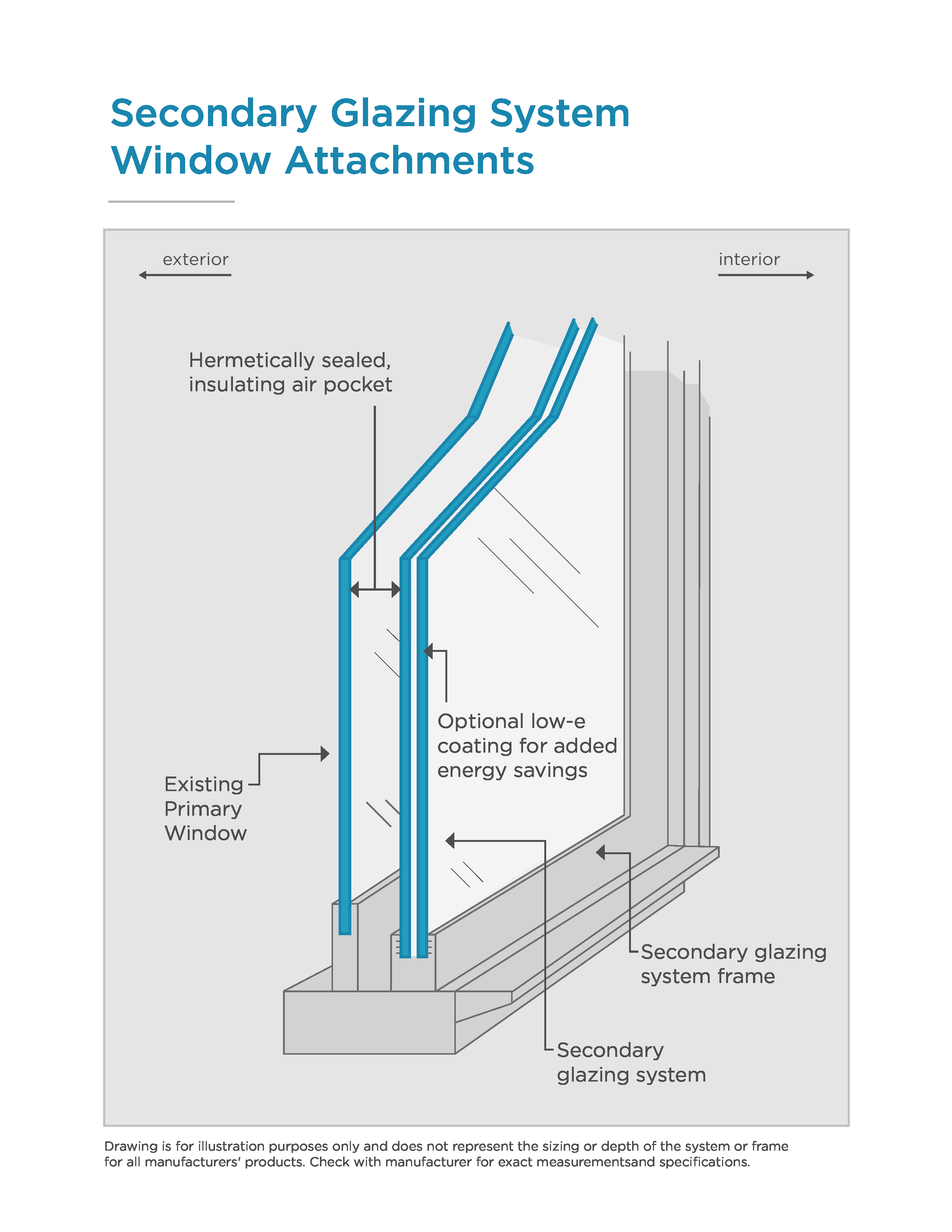By Christopher Meek, AIA, IES
Secondary glazing systems (SGS), sometimes referred to as interior window retrofitting products or accessory window products, are a simple straightforward solution to improving the performance of existing buildings at a reasonable cost and without disrupting occupants. The vast majority of energy consumption in the commercial and residential building sector stems from buildings that are more than 10 years old, as increased energy efficiency requirements have significantly reduced the carbon emissions and energy use of new buildings. These inefficient existing buildings include a large cohort of buildings built before 1990 and prior to the widespread adoption of double-pane insulated glazing. As the owners and tenants of existing buildings have become more aware of building performance due to municipal disclosure ordinances and energy tune-up programs such as programs in Seattle and New York City, and energy transparency tools such as EPA’s ENERGY STAR® Portfolio Manager, they have sought innovative and cost-effective improvements in existing and operating buildings. SGS has emerged as a cost-effective, non-disruptive answer.
High costs and associated disruptions have historically been major barriers to deep energy improvements to the building envelope, and particularly to the replacement of outdated window technology. To address this challenge, a number of window manufacturers have developed a variety of new technology options that are relatively easy to install, including SGS. Without requiring a full window replacement, SGS improves the window’s thermal performance by adding a new double-pane insulated glazing unit (IGU) to older single-pane or non-low-e glass.

As HVAC systems generally represent the largest energy end-use of most existing buildings, and improved window performance dramatically decreases the heating and cooling loads that must be met by a building’s HVAC system, windows are the key to unlocking deep savings in existing buildings. While the reduction in HVAC energy use provided by SGS can save substantial energy in and of itself, the vastly improved building envelope allows for further high-efficiency technology including advanced, super-efficient radiant heating and cooling systems and very-high efficiency heat-recovery ventilation technology. In many cases, this comprehensive approach has been shown to cut a building’s energy consumption in half.
Beyond improving the building’s envelope, SGS offers additional occupant comfort and business benefits. For instance, by reducing the heat and glare of the window, SGS products increase the comfort and productivity of people who occupy the perimeter spaces. In cooler climates, SGS technology will dramatically reduce the radiant cold effect of those positioned near existing single-pane window surfaces. In addition, in urban environments or near sources of noise such as airports, rail lines, and other transportation infrastructure, SGS products reduce the noise coming through the windows.
And building occupants will enjoy SGS for more than just improved thermal and acoustic comfort—they’ll also enjoy the non-disruptive installation process. In many cases, replacing windows in leased or otherwise occupied buildings can be disruptive to tenants, especially in the case of tall buildings where access to the exterior is difficult. Installed in 20 to 30 minutes per window, SGS solves this problem by offering a non-disruptive alternative to conventional full window and frame replacement.
According to a Navigant Report, SGS offers a cost-effective solution to the more than 3,000 commercial buildings in the Pacific Northwest with single-pane windows. This includes historic buildings, as SGS can adapt to existing window systems and therefore conform to historic buildings’ often significant restrictions about alterations to existing window systems.
While the main obstacle to the adoption of this technology is the limited awareness of its existence as an effective solution to under-performing single-pane windows, awareness is growing thanks to organizations like the Attachments Energy Rating Council (AERC)—a collaboration between the US Department of Energy and windows manufacturers. By providing scientifically supported industry-wide metrics for the performance of SGS, storm windows, blinds, and shades, AERC empowers decision-makers in the building industry to select products that decrease energy use and increase the thermal and acoustic comfort of their occupants—all without the disruption of a full window replacement.
ABOUT THE AUTHOR
Christopher Meek, AIA is Associate Professor of Architecture at the University of Washington and a registered architect. He is Director of the Integrated Design Lab (IDL) at the University’s College of Built Environments. In this role, he consults with design teams and building owners in the Pacific Northwest and nationally with a focus on building energy performance, daylighting, visual comfort, electric lighting, and climate responsive design. The Integrated Design Lab has extensive experience providing tools and practices that meet the most aggressive performance targets in existing and new buildings. Currently the IDL is providing technical support for deep-energy retrofits under the City of Seattle’s Tune-Up Accelerator program which is funded by the US Department of Energy to drive energy efficiency in existing commercial buildings. Prof. Meek teaches graduate and undergraduate level courses on building design, daylighting, electric lighting, and indoor environmental quality at the UW Department of Architecture.
